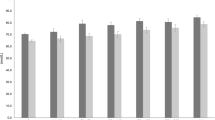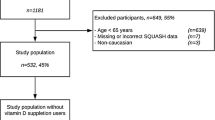Abstract
Purpose
Both low levels of vitamin D and of physical activity are associated with all-cause, cancer, and cardiovascular disease mortality. There is some evidence based on self-reported activity levels that physically more active individuals have higher vitamin D serum levels. The aim was to investigate associations between objectively measured and self-reported physical activity, respectively, and vitamin D serum concentrations in the US population.
Methods
Data from NHANES 2003–2006 (n = 6,370, aged ≥18 years) were analyzed using multiple regression analyses. A total of 6,370 individuals aged 18 years and older with valid data on vitamin D serum levels and physical activity were included. Objective physical activity was assessed using accelerometers; self-reported physical activity was based on the NHANES physical activity questionnaire.
Results
An increase of 10 min of objectively measured and self-reported moderate-to-vigorous activities per day was associated with an increase in circulating vitamin D of 0.32 ng/ml (95 % CI 0.17, 0.48) and of 0.18 ng/ml (95 % CI 0.12, 0.23), respectively. The odds ratio for being vitamin D deficient (<20 ng/ml) if being insufficiently active compared with being sufficiently active was 1.32 (1.11, 1.57). Associations were not stronger for self-reported outdoor activities compared with indoor activities.
Conclusions
Physical activity may be a way to achieve higher vitamin D serum levels in the population. Factors other than sun exposure that may be responsible for higher vitamin D levels in more active individuals need further investigation.

Similar content being viewed by others
References
Zittermann A, Iodice S, Pilz S, Grant WB, Bagnardi V, Gandini S (2012) Vitamin D deficiency and mortality risk in the general population: a meta-analysis of prospective cohort studies. Am J Clin Nutr 95(1):91–100. doi:10.3945/ajcn.111.014779
Rohrmann S, Braun J, Bopp M, Faeh D (2013) Inverse association between circulating vitamin D and mortality—Dependent on sex and cause of death? Nutr Metab Cardiovasc Dis. doi:10.1016/j.numecd.2013.05.005
Deng X, Song Y, Manson JE, Signorello LB, Zhang SM, Shrubsole MJ et al (2013) Magnesium, vitamin D status and mortality: results from US National Health and Nutrition Examination Survey (NHANES) 2001 to 2006 and NHANES III. BMC Med 11:187. doi:10.1186/1741-7015-11-187
Sempos CT, Durazo-Arvizu RA, Dawson-Hughes B, Yetley EA, Looker AC, Schleicher RL et al (2013) Is there a reverse J-shaped association between 25-hydroxyvitamin D and all-cause mortality? Results from the U.S. nationally representative NHANES. J Clin Endocrinol Metab 98(7):3001–3009. doi:10.1210/jc.2013-1333
Liu L, Chen M, Hankins SR, Nunez AE, Watson RA, Weinstock PJ et al (2012) Serum 25-hydroxyvitamin D concentration and mortality from heart failure and cardiovascular disease, and premature mortality from all-cause in United States adults. Am J Cardiol 110(6):834–839. doi:10.1016/j.amjcard.2012.05.013
Chowdhury R, Kunutsor S, Vitezova A, Oliver-Williams C, Chowdhury S, Kiefte-de-Jong JC et al (2014) Vitamin D and risk of cause specific death: systematic review and meta-analysis of observational cohort and randomised intervention studies. BMJ 348:g1903. doi:10.1136/bmj.g1903
Yin L, Ordonez-Mena JM, Chen T, Schottker B, Arndt V, Brenner H (2013) Circulating 25-hydroxyvitamin D serum concentration and total cancer incidence and mortality: a systematic review and meta-analysis. Prev Med 57(6):753–764. doi:10.1016/j.ypmed.2013.08.026
Jenab M, Bueno-de-Mesquita HB, Ferrari P, van Duijnhoven FJ, Norat T, Pischon T et al (2010) Association between pre-diagnostic circulating vitamin D concentration and risk of colorectal cancer in European populations: a nested case–control study. BMJ 340:b5500. doi:10.1136/bmj.b5500
Abbas S, Linseisen J, Slanger T, Kropp S, Mutschelknauss EJ, Flesch-Janys D et al (2008) Serum 25-hydroxyvitamin D and risk of post-menopausal breast cancer–results of a large case–control study. Carcinogenesis 29(1):93–99. doi:10.1093/carcin/bgm240
Kendrick J, Targher G, Smits G, Chonchol M (2009) 25-Hydroxyvitamin D deficiency is independently associated with cardiovascular disease in the Third National Health and Nutrition Examination Survey. Atherosclerosis 205(1):255–260. doi:10.1016/j.atherosclerosis.2008.10.033
Kabadi SM, Lee BK, Liu L (2012) Joint effects of obesity and vitamin D insufficiency on insulin resistance and type 2 diabetes: results from the NHANES 2001–2006. Diabetes Care 35(10):2048–2054. doi:10.2337/dc12-0235
Kabadi SM, Liu L, Auchincloss AH, Zakeri IF (2013) Multivariate path analysis of serum 25-hydroxyvitamin d concentration, inflammation, and risk of type 2 diabetes mellitus. Dis Markers 35(3):187–193. doi:10.1155/2013/497256
Freedman DM, Looker AC, Abnet CC, Linet MS, Graubard BI (2010) Serum 25-hydroxyvitamin D and cancer mortality in the NHANES III study (1988–2006). Cancer Res 70(21):8587–8597. doi:10.1158/0008-5472.CAN-10-1420
Scragg RK, Camargo CA Jr, Simpson RU (2010) Relation of serum 25-hydroxyvitamin D to heart rate and cardiac work (from the National Health and Nutrition Examination Surveys). Am J Cardiol 105(1):122–128. doi:10.1016/j.amjcard.2009.08.661
Physical Activity Guidelines Advisory Committee (2008) Physical activity guidelines advisory committee report 2008. U.S. Department of Health and Human Services, Washington
World Health Organization (2009) Global health risks: mortality and burden of disease attributable to selected major risks. WHO, Geneva
Zhao G, Li C, Ford ES, Fulton JE, Carlson SA, Okoro CA et al (2013) Leisure-time aerobic physical activity, muscle-strengthening activity and mortality risks among US adults: the NHANES linked mortality study. Br J Sports Med. doi:10.1136/bjsports-2013-092731
Richard A, Martin BW, Wanner M, Eichholzer M, Rohrmann S (2014) Effects of leisure-time and occupational physical activity on total mortality risk in NHANES III according to sex, ethnicity, central obesity and age. J Phys Act Health. doi:10.1123/jpah.2013-0198
Metzger JS, Catellier DJ, Evenson KR, Treuth MS, Rosamond WD, Siega-Riz AM (2008) Patterns of objectively measured physical activity in the United States. Med Sci Sports Exerc 40(4):630–638. doi:10.1249/MSS.0b013e3181620ebc
Troiano RP, Berrigan D, Dodd KW, Masse LC, Tilert T, McDowell M (2008) Physical activity in the United States measured by accelerometer. Med Sci Sports Exerc 40(1):181–188
Matthews CE, Chen KY, Freedson PS, Buchowski MS, Beech BM, Pate RR et al (2008) Amount of time spent in sedentary behaviors in the United States, 2003–2004. Am J Epidemiol 167(7):875–881. doi:10.1093/aje/kwm390
Schuna JM Jr, Johnson WD, Tudor-Locke C (2013) Adult self-reported and objectively monitored physical activity and sedentary behavior: NHANES 2005–2006. Int J Behav Nutr Phys Act 10(1):126. doi:10.1186/1479-5868-10-126
Scragg R, Camargo CA Jr (2008) Frequency of leisure-time physical activity and serum 25-hydroxyvitamin D levels in the US population: results from the Third National Health and Nutrition Examination Survey. Am J Epidemiol 168(6):577–586. doi:10.1093/aje/kwn163 discussion 87–91
Kluczynski MA, Lamonte MJ, Mares JA, Wactawski-Wende J, Smith AW, Engelman CD et al (2011) Duration of physical activity and serum 25-hydroxyvitamin D status of postmenopausal women. Ann Epidemiol 21(6):440–449. doi:10.1016/j.annepidem.2010.11.011
Brock K, Huang WY, Fraser DR, Ke L, Tseng M, Stolzenberg-Solomon R et al (2010) Low vitamin D status is associated with physical inactivity, obesity and low vitamin D intake in a large US sample of healthy middle-aged men and women. J Steroid Biochem Mol Biol 121(1–2):462–466. doi:10.1016/j.jsbmb.2010.03.091
McCullough ML, Weinstein SJ, Freedman DM, Helzlsouer K, Flanders WD, Koenig K et al (2010) Correlates of circulating 25-hydroxyvitamin D: cohort Consortium Vitamin D Pooling Project of Rarer Cancers. Am J Epidemiol 172(1):21–35. doi:10.1093/aje/kwq113
Millen AE, Wactawski-Wende J, Pettinger M, Melamed ML, Tylavsky FA, Liu S et al (2010) Predictors of serum 25-hydroxyvitamin D concentrations among postmenopausal women: the Women’s Health Initiative Calcium plus Vitamin D clinical trial. Am J Clin Nutr 91(5):1324–1335. doi:10.3945/ajcn.2009.28908
Tseng M, Giri V, Bruner DW, Giovannucci E (2009) Prevalence and correlates of vitamin D status in African American men. BMC Public Health 9:191. doi:10.1186/1471-2458-9-191
Johnson CL, Paulose-Ram R, Ogden CL, Carroll MD, Kruszon-Moran D, Dohrmann SM et al (2013) National health and nutrition examination survey: analytic guidelines, 1999–2010. Vital Health Stat 2(161):1–7, 7–10
Hendelman D, Miller K, Baggett C, Debold E, Freedson P (2000) Validity of accelerometry for the assessment of moderate intensity physical activity in the field. Med Sci Sports Exerc 32(9 Suppl):S442–S449
Melanson EL Jr, Freedson PS (1995) Validity of the Computer Science and Applications, Inc. (CSA) activity monitor. Med Sci Sports Exerc 27(6):934–940
Brage S, Wedderkopp N, Franks PW, Andersen LB, Froberg K (2003) Reexamination of validity and reliability of the CSA monitor in walking and running. Med Sci Sports Exerc 35(8):1447–1454. doi:10.1249/01.MSS.0000079078.62035.EC
Matthews CE (2005) Calibration of accelerometer output for adults. Med Sci Sports Exerc 37(11 Suppl):S512–S522
Pfeiffer C Laboratory procedure manual. 25-Hydroxyvitamin D in Serum. NHANES 2003–2004
Pfeiffer C (2008) Laboratory procedure manual. 25-Hydroxyvitamin D in Serum. NHANES 2005–2006
Forrest KY, Stuhldreher WL (2011) Prevalence and correlates of vitamin D deficiency in US adults. Nutr Res 31(1):48–54. doi:10.1016/j.nutres.2010.12.001
Wallace TC, Reider C, Fulgoni VL (2013) Calcium and Vitamin D disparities are related to gender, age, race, household income level, and weight classification but not vegetarian status in the United States: analysis of the NHANES 2001–2008 data set. J Am Coll Nutr 32(5):321–330. doi:10.1080/07315724.2013.839905
O’Neil CE, Keast DR, Fulgoni VL, Nicklas TA (2012) Food sources of energy and nutrients among adults in the US: NHANES 2003–2006. Nutrients 4(12):2097–2120. doi:10.3390/nu4122097
Samuel L, Borrell LN (2013) The effect of body mass index on optimal vitamin D status in U.S. adults: the National Health and Nutrition Examination Survey 2001–2006. Ann Epidemiol 23(7):409–414. doi:10.1016/j.annepidem.2013.05.011
Sabanayagam C, Shankar A, Somasundaram S (2012) Serum vitamin D level and prehypertension among subjects free of hypertension. Kidney Blood Press Res 35(2):106–113. doi:10.1159/000330716
Touvier M, Deschasaux M, Montourcy M, Sutton A, Charnaux N, Kesse-Guyot E et al (2015) Determinants of vitamin D status in Caucasian adults: influence of sun exposure, dietary intake, sociodemographic, lifestyle, anthropometric, and genetic factors. J Invest Dermatol 135(2):378–388. doi:10.1038/jid.2014.400
Maimoun L, Sultan C (2009) Effect of physical activity on calcium homeostasis and calciotropic hormones: a review. Calcif Tissue Int 85(4):277–286. doi:10.1007/s00223-009-9277-z
Fukumoto S (2014) Phosphate metabolism and vitamin D. Bonekey Rep 3:497. doi:10.1038/bonekey.2013.231
Corder K, Brage S, Ekelund U (2007) Accelerometers and pedometers: methodology and clinical application. Curr Opin Clin Nutr Metab Care 10(5):597–603. doi:10.1097/MCO.0b013e328285d883
Lips P (2001) Vitamin D deficiency and secondary hyperparathyroidism in the elderly: consequences for bone loss and fractures and therapeutic implications. Endocr Rev 22(4):477–501. doi:10.1210/edrv.22.4.0437
Clemens TL, Adams JS, Henderson SL, Holick MF (1982) Increased skin pigment reduces the capacity of skin to synthesise vitamin D3. Lancet 1(8263):74–76
Kimlin MG, Lucas RM, Harrison SL, van der Mei I, Armstrong BK, Whiteman DC et al (2014) The contributions of solar ultraviolet radiation exposure and other determinants to serum 25-Hydroxyvitamin D concentrations in Australian adults: the AusD Study. Am J Epidemiol. doi:10.1093/aje/kwt446
Conflict of interest
The authors declare that they have no conflict of interest.
Author information
Authors and Affiliations
Corresponding author
Electronic supplementary material
Below is the link to the electronic supplementary material.
Rights and permissions
About this article
Cite this article
Wanner, M., Richard, A., Martin, B. et al. Associations between objective and self-reported physical activity and vitamin D serum levels in the US population. Cancer Causes Control 26, 881–891 (2015). https://doi.org/10.1007/s10552-015-0563-y
Received:
Accepted:
Published:
Issue Date:
DOI: https://doi.org/10.1007/s10552-015-0563-y




